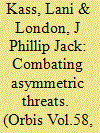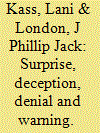| Srl | Item |
| 1 |
ID:
129909


|
|
|
|
|
| Publication |
2014.
|
| Summary/Abstract |
The overarching objective of this analysis is to examine the ways and means by which the United States could take the asymmetric battle-space and win against the ever-changing array of threats posed by nation-states and non-state actors. Today's security challenges are predominantly hybrids: offense and defense; symmetric and asymmetric; synchronous and asynchronous; regular and irregular; geographically-focused and globally-ubiquitous. This reality requires multi-dimensional thinking, nuanced approaches, and nimble, decisive execution guided by a new strategic paradigm. Fighting on the enemy's terms, scoring short-term wins at unjustifiably high costs in lives, treasure and lost opportunities is simply unacceptable.
|
|
|
|
|
|
|
|
|
|
|
|
|
|
|
|
| 2 |
ID:
118312


|
|
|
|
|
| Publication |
2013.
|
| Summary/Abstract |
This article frames the highly complex national security challenges of surprise, denial and deception. These ultimate asymmetric threats exploit vulnerabilities, capitalizing on hubris, complacency and self-delusion. Such actions prevent the full and accurate assessment of opponents' capabilities and intentions, and hinder appropriate actions. The long and frequent history of surprise, denial and deception suggest that these are essentially psychological phenomena. They are effective because they challenge and exploit perceptions that fill the gap between what is known and unknown. The authors present decision superiority as the fusion of information dominance and decisive action. Technology and intelligence can enhance decision superiority by ameliorating, but not eliminating, the limits of human perception. Translating knowledge into capabilities and actions requires agile, adaptive processes and open institutional collaboration within the interagency, with global allies and the private sector.
|
|
|
|
|
|
|
|
|
|
|
|
|
|
|
|